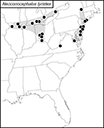|
Identification:
|
Length 45-57 mm for males and 55-67 for females. Cone prominent and slender, black beneath; side of pronotum with a deep almost right-angle notch at rear. Stridulatory vein thick and with pronounced subsidiary veins; first 10-15 teeth at lateral end of stridulatory file not conspicuously more widely spaced than subsequent teeth.
|
|
Habitat:
|
Bogs and freshwater marshes.
|
|
Season:
|
Aug.–Oct.
|
|
Song:
|
A high-pitched, smooth, continuous buzz produced in afternoon as well as evening.
|
|
Similar species:
|
N. nebrascensis is not restricted to bogs and marshes; on the side, its pronotum has a shallow, obtuse notch at rear; and the first 10-15 teeth at lateral end of stridulatory file are conspicuously more widely spaced than the remaining teeth. N. melanorhinus occurs on tidal flats and its cone is more robust. N. ensiger has a cone that is less than half black beneath and a stridulatory vein that is thin and long.
|
|
Remarks:
|
The species most closely related to N. lyristes is N. pahayokee, a species that is geographically more than 800 miles distant. N. lyristes itself has a noteworthy geographical separation: Midwest populations are separated by nearly 400 miles from Atlantic Coast populations (see map above). The intervening habitat is presently unsuitable, but at the end of the last glacial period a corridor of suitable habitat is believed to have connected the two regions via the Hudson and Mohawk valleys. A variety of plants and animals exploited the corridor and now show disjunct distributions comparable to that of the N. lyristes (for example, Orchelimum volantum). The Atlantic coast populations of N. lyristes exceed those of the Midwest in average body length and in cone length.
|
|
More information:
|
Subfamily Copiphorinae, genus Neoconocephalus.
|
|
References:
|
Thomas 1933.
|
|
Nomenclature:
|
OSF (Orthoptera Species File Online).
|











